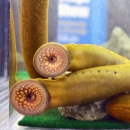About Us
Sea lampreys are a jawless parasitic fish native to the Atlantic Ocean. Invading the Great Lakes via manmade locks and shipping canals, their aggressive behavior and appetite for fish blood wreaked havoc on native fish populations. Sea lampreys decimated an already vulnerable lake trout fishery.
Ludington Biological Station was established by the U.S. Fish and Wildlife Service in 1956 to support sea lamprey research, monitoring and control efforts to fulfill U.S. obligations under the 1954 Convention on Great Lakes Fisheries between the United States and Canada and the Great Lakes Fishery Act of 1956. We work with state, tribal and other federal agencies to monitor progress towards fish community objectives for sea lampreys in each of the Great Lakes, but also to develop and implement actions to achieve these objectives. Activities are closely coordinated with state, tribal and other federal and provincial management agencies, non-government organizations, private landowners and the general public. Our primary goal is to conduct ecologically sound and publicly acceptable integrated sea lamprey control. Continued chemical treatments and use of barriers have resulted in increasingly healthier fish populations and an economic powerhouse fueled by the sport fishery. Sea lamprey control will continue to be important as lake trout restoration activities and lake sturgeon recovery efforts expand in the Great Lakes. Sea lamprey control is critical in the establishment of a diverse salmonine community and supporting sustainable harvests of walleye, rainbow smelt and trout, smallmouth bass, yellow perch and whitefish.
The Sea Lamprey Control Program is administered and funded by the Great Lakes Fishery Commission and implemented by two control agents, the U.S. Fish and Wildlife Service and Fisheries and Oceans Canada, who often partner on larger projects.
Our Mission
Ludington Biological Station was established by the U.S. Fish and Wildlife Service in 1956 to support the Sea Lamprey Control Program. Our primary goal is to conduct ecologically sound and publicly acceptable integrated sea lamprey control critical to the establishment of diverse and sustainable Great Lakes fish communities. Activities are closely coordinated with state, tribal and other federal and provincial management agencies, non-government organizations, private landowners and the general public.
Our History
1956 - Ludington Biological Station was established in Ludington, Michigan.
2016 - Ludington Biological Station was temporarily relocated to Manistee, Michigan.
2019 - The Great Lakes Fishery Commission started construction on a new facility in Ludington, Michigan.
Other Facilities in this Complex
Ludington Biological Station and Marquette Biological Station work together to deliver the Sea Lamprey Control Program in the U.S. waters of the Great Lakes.

